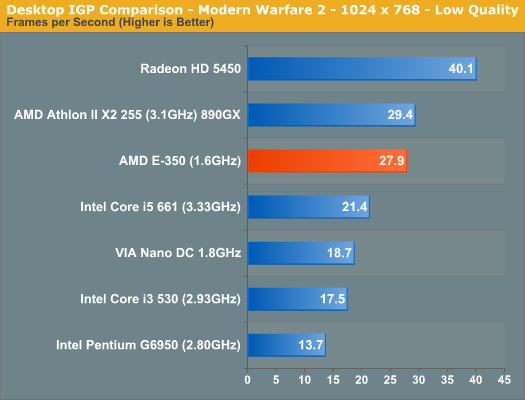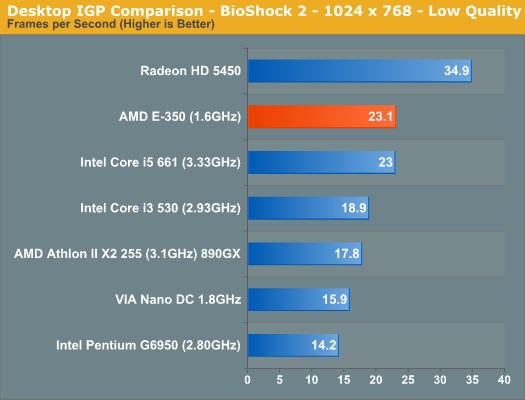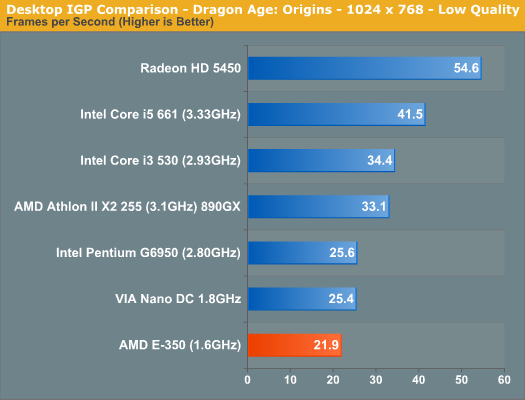The Brazos Performance Preview: AMD E-350 Benchmarked
by Anand Lal Shimpi on November 16, 2010 12:01 AM ESTDesktop IGP Comparison: Faster than Clarkdale
I split the graphics comparison into two sections: desktop and mobile. For the desktop section I compared the E-350 to the latest Clarkdale chips, AMD's own 890GX and a discrete Radeon HD 5450 graphics card. While the Radeon HD 5450 has the same number of shader processors as the E-350 (80), they run faster and it has a dedicated 1.6GHz memory bus to feed it. The E-350 has to share memory bandwidth between the two Bobcat cores and the 80 SPs, severely limiting its performance potential.


The E-350 does extremely well compared to its desktop brethren. In our Modern Warfare 2 and BioShock tests its easily faster than the Core i3/i5 and in the case of BioShock 2 it's even faster than AMD's 890GX. Dragon Age Origins is another story however as the benchmark is primarily CPU limited, giving the desktop parts a huge advantage. In GPU bound scenarios, it's clear that our initial Zacate benchmarking was accurate: the E-350's Radeon HD 6310 is quicker than Intel's HD Graphics.
Compared to the Radeon HD 5450 the 6310 offers between 66 - 69% of its performance in our GPU bound tests. The performance reduction is entirely due to the 6310's limited memory bandwidth being shared with the dual Bobcat cores on-die.











207 Comments
View All Comments
duploxxx - Tuesday, November 16, 2010 - link
TDP doesn't mean real world power consumption, I think you should look at a few other reviews first who did a better compare.... Zacate even owns atom 525 big time with ION and even better then single core atom.... what TDP again? :)http://hothardware.com/Reviews/AMD-Zacate-E350-Pro...
NST - Tuesday, November 16, 2010 - link
No, it isn't.E-350 has the same number of cores as I7-680UM(top of the line Intel CULV Processor that is supposedly available but nowhere to be found), higher frequency, better IGP and it comes at a far cheaper price.Also, Sandy Bridge, at its launch, won't bring new CULV chips, because the current line has been out for less than 6 months.So, no more competition for this segment.
8steve8 - Tuesday, November 16, 2010 - link
NST im not sure what your point is, yes the E350 has the same number of cores and the same TDP as all core i3/i5/i7 ULV parts, I'm not sure about price but they can be found in a variety of laptops, from the lenovo u160,u260,u460s, .... well almost every mfgr has a shipping laptop with a core iX ulv part (sans apple).laptops with these parts have been purchasable since june, and the e350 is only benchmarkable via an engineering platform... so its not exactly that close to market... even if it was.. seems like it can't compete vs core ix ulv. on anything other than price.
maybe if its super-cheap, it'll sell in a few netbooks vs atom.
NST - Tuesday, November 16, 2010 - link
1. E-350 has much better power consumption.2. E-350 has better GPU performance.
3. Intel CULVs are based on a better architecture however, E-350 has a higher frequency, which is crucial for 720p gaming.
As a gamer, what I see here is the potential for ultraportable notebooks with gaming performance close to this of Alienware M11x and never before seen battery life at the cost of an Atom-based netbook.
I do not question Intel's current supremacy in every segment but I think that next year Intel will face some strong competition from AMD.And that's good for us customers.
mino - Tuesday, November 16, 2010 - link
And you forgot the most important point - Brazos is playing in a completely different price bracket.The Atom price bracket.
Dark_Archonis - Tuesday, November 16, 2010 - link
Brazos is aiming at the $300-500 market. Guess what, there are some Celeron systems that fall in that price bracket as well.8steve8 - Tuesday, November 16, 2010 - link
1. does it have much better power consumption? the tdp's are the same, ive yet to see ulv arrandale vs e350, total system power consumption.2. yes, it has better gpu performance
3. the e350 has higher non-turbo frequencies than ulv arrandales, but why do you think that's crucial for 720p gaming... by that logic the 3.6Ghz pentium 4 is better suited for gaming than a 3Ghz sandy bridge cpu... which is false.
NST - Wednesday, November 17, 2010 - link
1.All you got to do is check the review of a laptop featuring an Arrandale ULV chip and then compare the power consumption.There plenty out there.Plus AMD stated that E-350's idle power consumption would be even lower in the final product.3. 720p gaming--->More CPU dependant
1080p, 1600p etc--->More GPU dependant
Generally about gaming, in higher resolutions, GPU becomes more and more important than the CPU.What I meant was that in a game that utilizes 2 cores E-350 will have an edge due to the higher frequency.And yes, if you find a game that utilizes only one CPU core (probably an old one) the Pentium will probably manage to hold his own against Sandy Bridge.
Khato - Wednesday, November 17, 2010 - link
1. How about the ~10W consumption of the Alienware M11x R2 while running the Anandtech Internet battery life test? That's a i7-640UM that'll ramp up to 2.27GHz when it's needed.With respect to other power consumption figures... It's mildly annoying how other sites are typically comparing desktop/'nettop' systems to the 'brazos' demo platform. After all, take a look at the power consumption of any actual notebook/netbook implementation of the same processors and suddenly the power consumption numbers of the 'brazos' demo platform is simply in line/above the competition rather than far below it...
If interested in other power numbers, the Anandtech "Intel Core 2 CULV Roundup" published earlier this year has some good figures for both atom and CULV. For example, the Asus 1005PE with the single-core atom N450 at 1.66GHz consuming a massive 9.5 watts under 100% CPU load. So theoretically an N550 with its 3 watt higher TDP would get up to all of 12.5 watts... Of course more interesting is the fact that the 1.3GHz CULV notebooks in that review are at all of 19 watts under 100% CPU load - so comparable power consumption, despite being faster and on a 45nm process tech instead of 40nm (though the Intel 45nm is roughly equal to TSMC 40nm, if not better.)
mino - Tuesday, November 16, 2010 - link
Do you see those ULV chips selling for Atom prices as Zacate and Ontario are ?You are comparing an enduro to a moped while complaining the latter is slower.
Hell it is. IT IS SUPPOSED TO BE.
The fact that Zacate is actually considered an alternative to ULV series at 1/3 the cost is a HUGE success on itself.